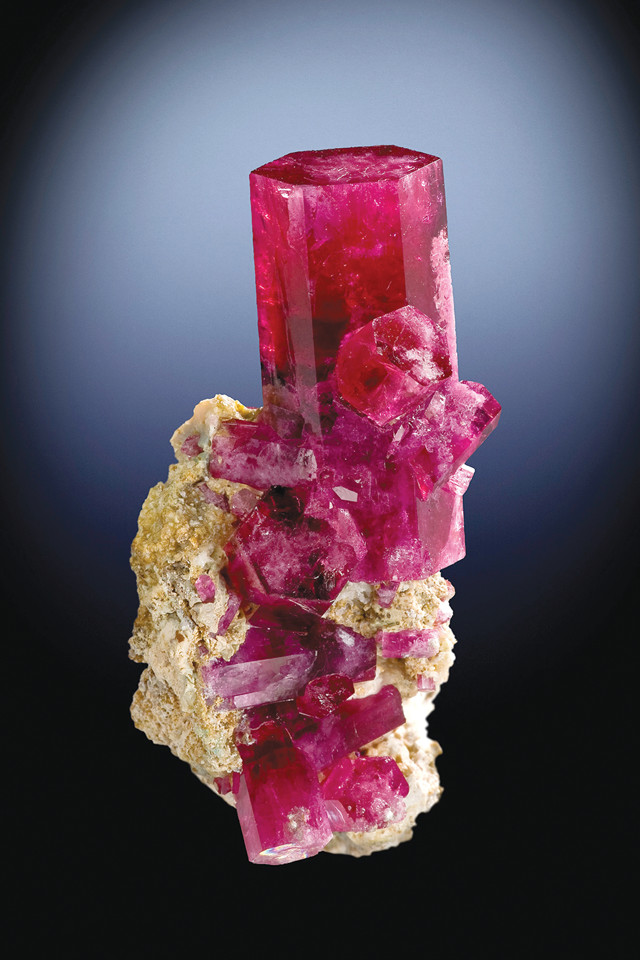
by U.S. Geological Survey Friday, July 17, 2015
U.S. Geological Survey mineral commodity specialist Donald W. Olson has compiled the following information on gemstones, which are prized above other minerals for their beauty, rarity and worth.

Red beryl, also known as scarlet or red emerald, is one of the rarest gemstones in the world, selling for as much as 0,000 per carat. Credit: ©Rob Lavinsky, iRocks.com – CC-BY-SA-3.0.
Gemstones have been treasured objects throughout history, often serving as symbols of power and status for rulers and the wealthy. Stones used in early jewelry-making include amber, amethyst, coral, diamond, emerald, garnet, jade, jasper, lapis lazuli, pearl, rock crystal, ruby, serpentine and turquoise.
The term gemstone is used for any natural mineral (or synthetic substitute) used for personal adornment, display, or as an object of art because it possesses beauty, durability and rarity. Out of more than 4,000 known mineral species, only about 100 possess such attributes. Gemstones also include some materials not technically considered to be minerals, such as organic materials like amber, or materials derived from organic processes like pearl. Diamond, emerald, ruby and sapphire are “precious” gemstones; the remaining gemstones are “semi-precious.” Silicates, including quartz, make up the largest group of gemstone minerals.
More than 60 varieties of gemstones have been produced from U.S. mines, but commercial gemstone mining has never been extensively undertaken. Most U.S. gemstone production has come from relatively small mining operations, or as a byproduct of mining other mineral commodities. In the United States, much of the current gemstone mining is conducted by collectors and hobbyists, rather than commercial outfits. Cultured, laboratory-created or synthetic gemstones have the same chemical, optical and physical properties as their natural counterparts.
Ten states make up almost 90 percent of U.S. natural gemstone production. Some states are known for the production of a single gem mineral, such as Tennessee, which is known for its freshwater pearls. North Carolina is the only state where all four precious gemstones have been found.
Overall, demand for gem-quality diamonds and precious colored gemstones is expected to rise. The United States is expected to continue dominating world gemstone consumption.
For more information on gemstones and other mineral resources, visit minerals.usgs.gov/minerals.
In 2014, the combined value of U.S. natural and synthetic gemstone production was $66.6 million.
The estimated world production of gemstone-grade diamond was 74.1 million carats in 2014.
In 2014, estimates suggested the U.S. market accounted for more than 35 percent of world diamond consumption.
Diamond is the hardest gemstone; amber is the softest.
Between 1972, when Crater of Diamonds opened as a dig-for-fee state park, and the end of 2014, a total of 6,294.20 carats of diamonds had been found by park visitors.
Fossilized tree sap must be at least 30 million years old to be considered amber.
Garnet necklaces dating from the Bronze Age have been found in graves, and garnet is found among the ornaments adorning the oldest Egyptian mummies.
Although sapphire is commonly thought of as a blue gemstone, it can occur in many colors. In fact, sapphire and ruby are both gem-quality versions of the same mineral, corundum.
There is no mineral called “jade.” Jade is either one of two different minerals, jadeite or nephrite. Jadeite is the more valuable of the two.
© 2008-2021. All rights reserved. Any copying, redistribution or retransmission of any of the contents of this service without the expressed written permission of the American Geosciences Institute is expressly prohibited. Click here for all copyright requests.